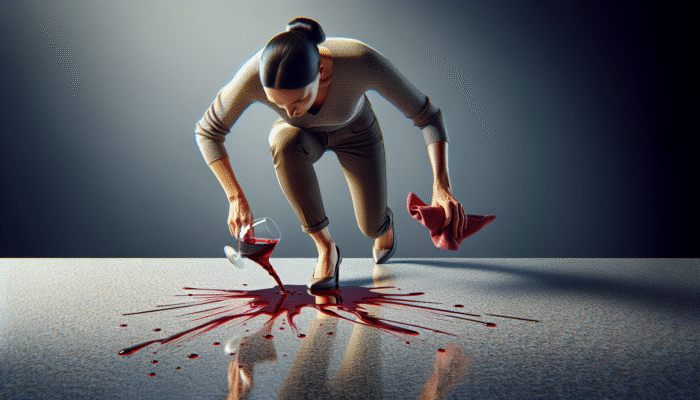Summary of this article “Ultimate Guide to Maintaining Granite Floors for Lasting Beauty: Essential Care Strategies”:
- Granite floors exhibit timeless beauty and strength but require consistent care to maintain their stunning appearance.
- Details essential daily cleaning habits, emphasizing the importance of dust-mopping and using pH-neutral cleaners to prevent dullness and damage caused by abrasive particles.
- Highlights the necessity of quick spill response and protective strategies, such as area rugs, in high-traffic areas to prevent staining and deterioration.
- Underscores the importance of regular sealing to guard against moisture penetration and ensure the durability of the flooring.
- Offers thorough cleaning recommendations, specifying the optimal frequency and the best products or methods to apply.
- Discusses polishing techniques that rejuvenate the shine and maintain granite’s pristine look without excessive application.
- Encourages seeking professional assistance when necessary, especially for restoration or significant resealing tasks.
- Provides valuable product suggestions and maintenance methods specifically designed for granite care, steering clear of acidic or abrasive solutions.
In-Depth Exploration of Granite Characteristics and Maintenance Strategies
Granite stands out as a remarkable natural stone celebrated for its unique patterns and exceptional durability. Its visual appeal has captivated both homeowners and interior designers alike. Understanding the fundamental properties of granite is crucial for effectively caring for your granite floors over time. This section delves into its intricate composition, varying levels of porosity, and overall resilience, providing you with the essential insights needed to maintain your granite floors with confidence and accuracy.
Mastering Granite’s Composition for Optimal Maintenance

Granite consists of a rich array of minerals, predominantly quartz, feldspar, and mica, contributing to its signature flecked appearance. The specific combination of these minerals not only enhances the visual allure of granite but also influences its strength and resilience. Classified as an igneous rock, granite is formed from the gradual crystallization of magma below the Earth’s surface. This geological process grants the stone significant durability, making it a preferred choice for flooring in environments with high foot traffic.
The considerable quartz content in granite provides a glossy surface that enhances its visual charm while also contributing to its scratch resistance. Feldspar boosts the stone’s hardness, ensuring that granite can withstand the rigors of everyday use, while mica imparts a shimmering quality that elevates its aesthetic appeal even further. Gaining a deep understanding of granite’s composition is essential for homeowners committed to preserving its beauty over time. Recognizing that each granite slab features unique characteristics allows you to appreciate its individuality and make informed decisions regarding its maintenance.
Recognizing Granite’s Porosity: The Essential Role of Sealing
Though granite is renowned for its robust nature, it is not entirely impervious to staining. The porosity of granite can vary significantly, with some varieties being more absorbent than others. This variability means that liquids can seep into the stone, resulting in unsightly stains and potential damage if not addressed swiftly. Regular sealing is paramount for protecting granite floors, establishing a protective barrier that prevents moisture and spills from penetrating the stone.
Typically, it is advisable to apply a high-quality sealant every one to two years, depending on the floor’s usage and the specific type of granite. When selecting a sealant, opt for products specifically formulated for natural stone to ensure compatibility and effectiveness. The sealing process is generally straightforward but should be approached with care. Thoroughly clean the floor before application and adhere strictly to the manufacturer’s instructions to achieve uniform coverage. A well-sealed granite floor not only resists stains but also maintains its radiant appearance, underscoring the vital role sealing plays in your long-term granite floor care plan.
Assessing the Durability of Granite and Addressing Possible Damage
Granite is lauded for its remarkable durability, yet it is not completely immune to damage. While it resists scratches and chips, neglecting proper care can lead to surface wear over time. Dropping heavy objects on granite floors may result in chips, while using abrasive materials can dull the surface finish. Understanding these factors is crucial for homeowners who wish to protect their investment and keep the stone in pristine condition.
To minimize wear and tear, thoughtfully plan the arrangement of your furniture and the positioning of heavy items. Employ protective pads under furniture legs and avoid dragging objects across the surface to mitigate scratches. Regularly inspecting your granite floors can help identify potential issues early on. Addressing minor imperfections promptly can significantly extend the lifespan of your granite flooring. By adopting a proactive maintenance strategy, you ensure that your floors remain beautiful and functional for many years to come.
Establishing Effective Daily Care Routines for Granite Floors

Creating effective daily maintenance routines is crucial for preserving your granite floors in immaculate condition. Regular care not only enhances the stone’s appearance but also acts as a protective measure against stains and damage. This section outlines essential daily practices that contribute to the longevity and beauty of granite flooring, simplifying the implementation of a consistent care regimen.
Regular Sweeping and Dusting: A Key Element in Granite Protection
Regular sweeping or dusting is a simple yet profoundly effective method for safeguarding your granite floors from the damaging effects of dust and grit. Dust and debris can accumulate rapidly, especially in high-traffic areas, leading to scratches when stepped on. Utilizing a soft-bristle broom or a dust mop allows for the gentle removal of particles without risking harm to the surface.
Incorporate this task into your daily cleaning routine for optimal results. Consider performing a quick sweep at the close of each day in busy households to prevent grit buildup. A vacuum equipped with a floor attachment designed for hard surfaces can serve as an efficient alternative to sweeping, effectively removing dust and debris without scratching. Consistency in this practice is critical for long-term granite floor care, preventing minor scrapes from escalating into significant damage.
Perfecting Mopping Techniques for Comprehensive Granite Care
Mopping forms a fundamental component of daily maintenance for granite floors, but utilizing the correct techniques is crucial to avoid damaging the sealant. Use a damp mop along with a pH-neutral cleaner specifically formulated for stone surfaces. Avoid acidic or alkaline cleaners, as these can erode the sealant and result in etching over time.
When mopping, ensure that the mop is only slightly damp to prevent excess water from pooling on the surface, which can seep into the stone. After mopping, follow up with a dry microfiber cloth to ensure no moisture remains, which could compromise the integrity of the granite. By maintaining this practice, you will keep your floors looking their best and ensure they continue to be a stunning feature of your home.
Promptly Managing Spills: An Essential Step for Granite Longevity

Spills are a frequent occurrence in daily life, particularly in bustling households. However, the speed of your response can significantly impact the longevity of your granite floors. Immediate attention to spills is critical, especially with acidic substances like wine, citrus juices, or vinegar, which can cause staining and etching if left unattended.
Keep a soft cloth or paper towel readily available for swift cleanups. Gently blot the spill, avoiding vigorous rubbing that could spread the liquid further or scratch the surface. A mild pH-neutral cleaner can be used for stubborn stains, but always test it on a small, inconspicuous area first. By cultivating a habit of promptly managing spills, you can minimize the risk of long-term damage and keep your granite floors in impeccable condition.
Conducting Regular Sealant Inspections for Granite Protection
Routine inspections of the sealant on your granite floors are essential for ensuring they remain safeguarded against stains and damage. Over time, even the highest-quality sealants can degrade, particularly in areas with heavy foot traffic. Performing a simple water test can help you evaluate the sealant’s effectiveness. Pour a small amount of water onto the floor; if it beads up, the sealant is still intact. If the water seeps in, it’s time to reapply the sealant.
Make it a habit to check your granite floors every few months to ensure that the sealant is performing effectively. This proactive approach not only saves you from potential headaches in the future but also enhances the overall aesthetic appeal of your flooring. Reapplying sealant as needed is a fundamental aspect of long-term granite floor care, preserving its beauty and functionality for years.
Enhancing Granite Floor Longevity with Protective Mats
In high-traffic areas, strategically placing protective mats or rugs can significantly reduce wear and tear on your granite floors. These mats serve as a barrier against dirt and debris that can scratch the surface, providing an additional layer of protection. Choose mats crafted from natural fibers that are gentle on your flooring and avoid those with rubber backing, as they can retain moisture and cause damage.
Position mats at entry points and areas prone to spills, such as the kitchen or dining room. Mats not only safeguard your granite but also enhance the aesthetic appeal of your home. Regular cleaning and maintenance of these mats will ensure they continue to fulfill their protective role, contributing significantly to your granite floors’ long-term care.
Choosing the Right Cleaning Solutions and Tools for Granite Floors
Selecting the appropriate cleaning solutions and tools is vital for maintaining the stunning appearance of your granite floors. Using unsuitable products can result in irreversible damage, making careful selection essential. This section explores recommended cleaners, tools to avoid, and practical DIY cleaning solutions to ensure your granite remains as beautiful as the day it was installed.
Optimal Cleaners for Granite Floors
When choosing cleaners for granite floors, it is crucial to select products specifically formulated for stone surfaces. Mild, pH-neutral cleaners are ideal, as they effectively cleanse without harming the sealant or the stone itself. Look for reputable brands that specialize in stone care within their product lines to ensure effectiveness and safety.
Additionally, consider creating a simple homemade solution by mixing a few drops of mild dish soap with warm water. This gentle concoction can cleanse your granite without the risk of harsh chemicals, making it a safe option for daily use. Always utilize a soft cloth or mop when applying any cleaner to avoid scratches, and remember that less is often more when it comes to cleaning agents.
Avoiding Tools That Can Damage Granite Surfaces
Steering clear of abrasive tools and harsh chemicals is imperative for maintaining granite floors. Steel wool, scouring pads, and abrasive brushes can scratch the surface, leading to dullness and damage over time. Similarly, strong acids and alkaline cleaners can etch the surface, ruining the finish and compromising the sealant.
Instead, invest in soft-bristle brushes and non-abrasive mops specifically designed for delicate surfaces. Always check product labels to ensure compatibility with natural stone. Using the right tools can significantly affect the preservation of your granite’s beauty and ensure its longevity. By avoiding harmful cleaning methods, you will be well on your way to effectively caring for granite floors for the long term.
Creating DIY Cleaning Solutions for Granite Maintenance
Formulating your own cleaning solutions can be a cost-effective and efficient way to maintain your granite floors. A simple mixture of warm water and a few drops of mild dish soap offers a safe yet effective cleaning solution. This blend can lift dirt and grime without posing a risk to your floors.
For tougher stains, consider adding baking soda to the mixture. A paste made from baking soda and water can be applied to the stained area and left for a few minutes before wiping away. This natural remedy is gentle yet effective, making it an excellent choice for homeowners who prefer eco-friendly cleaning solutions. Always rinse the area with clean water after DIY cleaning to eliminate residue, ensuring your granite remains pristine.
Implementing Periodic Deep Cleaning Practices for Granite
Periodic deep cleaning is essential for maintaining the allure of your granite floors. While daily maintenance is important, conducting a thorough clean every few months ensures that deeply embedded dirt and grime are effectively eliminated. This section outlines the recommended frequency, steps, and options for deep cleaning your granite flooring, ensuring it continues to be a striking feature in your home.
Establishing the Frequency of Deep Cleaning for Granite
For the majority of households, deep cleaning granite floors every three to six months is ideal. This frequency may vary based on factors such as foot traffic, the presence of pets, and your home’s specific conditions. Homes with high traffic or frequent spills may require more regular deep cleans to maintain the floors’ appearance.
Monitoring the condition of your floors can assist in determining the appropriate cleaning schedule. If you notice a dull appearance or believe that dirt has accumulated, it may be time for a deep clean. This proactive approach not only enhances the beauty of your granite but also helps prevent potential long-term damage, emphasizing the significance of periodic deep cleaning in caring for granite floors over time.
Steps for Effectively Deep Cleaning Granite Floors
Deep cleaning granite floors necessitates a systematic approach to ensure thorough and effective cleaning. Begin by sweeping or vacuuming to remove loose dirt and debris. Next, prepare a solution of a pH-neutral stone cleaner diluted in warm water. Using a soft-bristle brush, gently scrub the surface, paying particular attention to grout lines and areas needing extra care.
After scrubbing, rinse the area with clean water to remove any residue from the cleaning solution, ensuring a streak-free finish. Finally, dry the floor with a microfiber cloth to absorb moisture and enhance shine. Regular deep cleaning not only rejuvenates your floors but also provides an opportunity to check for any signs of wear or damage, allowing for timely repairs and maintenance.
Considering Professional Cleaning Services for Granite Maintenance
While many homeowners can manage routine cleaning, hiring professional stone care services for deep cleaning and restoration of granite floors can be a valuable investment. These specialists possess the expertise and equipment needed to effectively tackle stubborn stains, scratches, and etching that may be beyond the scope of standard cleaning efforts.
Professional services often include advanced cleaning techniques, such as honing and polishing, which can restore granite to its original sheen. Scheduling a professional deep clean every few years can ensure your floors remain in top condition, providing peace of mind and protecting your investment. Furthermore, professionals can offer tailored advice on ongoing maintenance suited to your specific granite type and usage.
Essential Equipment and Supplies for Deep Cleaning Granite
Having the appropriate equipment and supplies available is crucial for effectively deep cleaning your granite floors. A high-quality pH-neutral stone cleaner is essential, as it protects the integrity of the granite while ensuring a thorough clean. Soft-bristled brushes and non-abrasive mop heads also prevent scratching, ensuring the surface remains unblemished.
Microfiber cloths are invaluable, as they are gentle on surfaces, highly absorbent, and effective at picking up dirt. A bucket for mixing cleaning solutions and rinsing is necessary, and having access to a wet-dry vacuum can simplify the cleaning process. Equipping yourself with the right tools streamlines the deep cleaning process and enhances your ability to care for granite floors over the long term.
Strategies for Preventing Damage and Wear on Granite Floors
Implementing preventive measures is essential in preserving the beauty and integrity of your granite floors. This section discusses various strategies to protect your granite from scratches, stains, and other forms of wear, ensuring it remains a focal point of your home for years to come.
Utilizing Rugs and Mats for Enhanced Granite Floor Protection
Rugs and mats create an effective barrier to protect granite floors from scratches and general wear. By placing them in high-traffic areas, such as entryways and hallways, you can significantly lessen the amount of dirt and grit that contacts the stone. Choose mats crafted from natural fibers that will not harm the granite’s surface.
Regular maintenance of these mats is also vital; frequent washing and vacuuming help maintain their effectiveness in trapping dirt before it scratches your floors. Moreover, rugs can serve a dual purpose by enhancing the aesthetic appeal of your space while protecting your investment. By incorporating rugs into your home, you’re contributing to the long-term care of your granite floors and boosting their resilience against wear.
Implementing Furniture Protection Strategies to Prevent Damage
One of the most common causes of damage to granite floors is the movement of furniture. To prevent scratches, always use felt pads under the legs of your furniture. These pads create a soft barrier that allows for easy movement without damaging the granite surface. Regularly check and replace worn-out pads to ensure ongoing protection.
When rearranging furniture, lift rather than drag items across the floor. This simple practice can greatly reduce the likelihood of scratches and chips. By prioritizing furniture protection, you can maintain the beauty of your granite flooring and extend its lifespan, ensuring it remains a cherished feature of your home.
Avoiding Harsh Chemicals for Effective Granite Maintenance
Using harsh chemicals on granite floors can lead to significant damage, including etching and dulling of the surface. Acidic cleaners, such as vinegar or lemon juice, should be strictly avoided, as they can erode the stone’s finish. Instead, opt for pH-neutral cleaners specifically designed for natural stone care.
Educating all household members about the proper cleaning methods for granite is essential. Promoting awareness around the types of products to avoid and the appropriate cleaning techniques greatly reduces the risk of unintended damage. This knowledge is vital for anyone committed to caring for granite floors long-term, ensuring their beauty is preserved for years to come.
Comprehensive Long-Term Care and Restoration Strategies for Granite
Long-term maintenance of granite floors involves consistent care, periodic inspections, and timely restoration efforts. This section outlines essential strategies for ensuring your granite surfaces remain stunning and functional over the years, safeguarding your investment in this beautiful material.
The Critical Importance of Regular Sealing for Granite Floors
Reapplying sealant every one to two years is vital for protecting granite floors from stains and preserving their beautiful appearance. The frequency of resealing may depend on the specific type of granite, its usage, and environmental conditions.
When selecting a sealant, ensure it is compatible with natural stone to provide optimal protection. The sealing process is relatively simple: clean the floor thoroughly, apply the sealant evenly, and allow it to cure according to the manufacturer’s instructions. This practice not only protects the granite but also contributes to its shine, significantly enhancing long-term granite floor care.
Repairing Scratches and Chips on Granite Surfaces for Longevity
Despite the best care, scratches and chips can occur. Minor scratches may often be buffed with a polishing compound formulated specifically for granite. However, for deeper chips, it may be necessary to seek professional assistance. These experts can effectively repair and restore the surface, ensuring it looks as good as new.
Address any imperfections promptly to prevent further damage. Regular inspections enable you to catch issues early, making repairs more manageable and less expensive. By prioritizing timely restoration, you contribute to the longevity and visual appeal of your granite floors, ensuring they remain a treasured asset in your home.
Polishing Techniques for Maintaining Shine and Aesthetic Appeal
Regular polishing is vital for preserving the shine of your granite floors. A stone polish formulated for granite can help restore the surface’s luster. Polishing can be performed every few months or more frequently in high-traffic areas to keep the floors looking their finest.
Follow the manufacturer’s instructions closely to achieve optimal results. A polished finish enhances the natural beauty of granite, making it a captivating feature in your home. Regular polishing is a key element of caring for granite floors long-term, ensuring they continue to reflect light beautifully and retain their elegant appearance.
Scheduling Periodic Professional Inspections to Ensure Granite Care
Scheduling professional inspections for your granite floors every few years can be an invaluable investment in their longevity. Professionals can assess the condition of your granite and identify potential issues such as wear, damage, or insufficient sealing.
They can also offer tailored recommendations for maintenance and care suited to your specific flooring type and usage patterns. By addressing problems early, you can avoid more extensive repairs later on. Incorporating professional inspections into your long-term care routine ensures your granite floors remain in optimal condition, demonstrating your commitment to caring for granite floors long-term.
Your Frequently Asked Questions Addressed on Granite Care
How frequently should I clean my granite floors for optimal maintenance?
Granite floors should be cleaned routinely, with daily sweeping and mopping as necessary. Deep cleaning every three to six months is recommended to maintain both appearance and integrity.
Is vinegar a suitable cleaner for granite floors?
No, vinegar is acidic and can damage the sealant on granite floors. Instead, for proper care, opt for a pH-neutral cleaner specifically designed for stone surfaces.
How can I determine if my granite requires sealing?
Perform a water test by pouring a small amount of water on the surface. If it beads up, the sealant is still intact; if it absorbs, it’s time to reseal for optimal protection.
What actions should I take if I notice scratches on my granite floor?
Minor scratches can usually be buffed out with a stone polishing compound. For deeper scratches or chips, consider hiring a professional for effective repairs and restoration.
Is it safe to use baking soda on granite surfaces?
Yes, baking soda is a gentle abrasive and can be used in a paste for spot cleaning; however, ensure that you rinse thoroughly afterward to remove any residue that may affect the stone.
What strategies can I employ to effectively prevent stains on my granite floors?
The best strategies for preventing stains include regular sealing and immediate attention to spills. Additionally, placing mats in high-traffic areas enhances protection and reduces wear.
Is it advisable to use a steam cleaner on granite floors?
Steam cleaners are not recommended for granite, as the high heat and moisture can compromise the sealant and potentially damage the stone over time.
What type of mop is best suited for cleaning granite floors?
A mop with a soft, non-abrasive head, such as a microfiber mop, is ideal for cleaning granite floors without scratching the surface and ensuring effective maintenance.
How long does a granite sealant typically last?
A granite sealant usually lasts one to two years, but this can vary depending on usage and the specific granite type. Regular inspections will help determine the appropriate time for reapplication.
Should I consider hiring a professional to deeply clean my granite floors?
While regular maintenance can be performed independently, hiring a professional for deep cleaning can provide a thorough clean and restoration that might not be achievable through regular methods, ensuring your floors retain their beauty.
The Article Ultimate Guide to Maintaining Granite Floors for Lasting Beauty: Essential Care Strategies first appeared on https://london-stone.co.uk
The Article Granite Floor Care: Essential Tips for Longevity appeared first on https://fabritec.org
The Article Granite Floor Care Tips for Long-Lasting Beauty Was Found On https://limitsofstrategy.com

